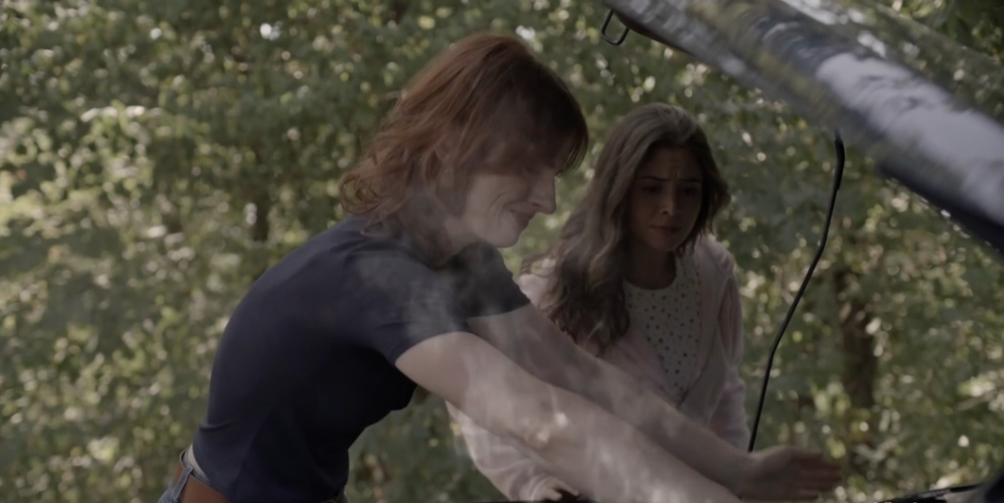What starts out as a bittersweet road trip for a mother and daughter pair quickly devolves into a waking nightmare in Lifetime’s ‘Kidnapped in a Small Town.’ Directed by Mike Hoy, the story follows Sarah, whose daughter Ruby seemingly vanishes into thin air following Allie’s nefarious schemes. Refusing to let go of her daughter without a fight, Sarah takes matters into her own hands, investigating the length and breadth of the small town she finds herself in, determined to find the clues that will lead her to the truth By approaching such a pressing issue through the lens of the dynamic between Sarah and Ruby, the movie places its conflict in a profoundly emotional context, resonating with the audience and cautioning them to the potential horrors that often lurk freely on the road.
Kidnapped in a Small Town Uses Fiction to Explore the Dangers of the Road
While ‘Kidnapped in a Small Town’ is largely a work of fiction penned by writers Jesse Mittelstadt and Richard Switzer, its premise is not without broader parallels to real-life horrors. The narrative’s primary twist is driven by Ruby’s sudden disappearance, which her mother soon realizes is due to her being kidnapped while with a stranger. Although the film was lensed in Kentucky and featured its long, wide roadways marked by lush greenery on both sides, through the perspective of the fictional narrative, the location gains a new perspective, as these very roads also serve as ample grounds for criminal activity, necessitating improvements in infrastructure and citizen protection. As such, while the story might not take place in Kentucky itself, it is definitely formed by the stories and dangers of being left alone on the road.

Sarah’s cruel circumstances and poor judgment lead to the prolonged exploitation of her child. While the film presents this as a fictional exercise, the kidnapping of hitchhikers or people stranded on the road is, unfortunately, a real-life occurrence. According to the FBI, between 1979 and 2009, there were 675 reported victims of sexual assault and/or murder along the Interstate Highways. The situation is further complicated due to the difficulty of tracking down these offenses and creating a complete statistical profile. The movie expressly makes use of this grey line, as Allie, the person responsible for driving Ruby to safety, claims to have never met or interacted with the women before. This simple refusal leaves Sarah utterly helpless, highlighting the pitfalls of relying on a system as unreliable as hitchhiking.
Many Real-Life Cases Echo the Point of Kidnapping in a Small Town
Over the years, more cases of roadside kidnapping and subsequent crimes have been documented, with a few of them bearing a vague resemblance to the movie’s creative rendition. On February 28, 2023, Alberto Angulo Lopez, a resident of Miami, allegedly attacked and sexually assaulted a woman who believed he was her rideshare driver. The victim explained the events, stating that she had initially brought her own vehicle, but it was towed, leaving her with no choice but to get a cab to the tow stations along with her friend. At one point, the 25-year-old claimed that she woke up to her driver trying to assault her, and she put up a valiant fight, successfully thwarting his attempts, before extracting his personal information through his payment details, which eventually led to the alleged perpetrator’s arrest.

However, not many have been fortunate enough to survive their ordeals. Thor Christiansen, infamously known as the Hitchhiker Slayer, was single-handedly responsible for the death of four women hitchhikers in Southern California, nearly managing to claim a fifth life on April 18, 1979, that of Lydia Presto. While at gunpoint, she managed to survive with a wound in the ear and dove out of the car before heading to the nearest hospital. Lydia eventually found Thor again on July 11, 1979, this time sitting in a bar in Hollywood, and she wasted no time in reporting it to the police, leading to his arrest. Both these cases have a few things in common with their fictional counterpart — the breakdown of the victim’s personal vehicle, the lies about safe transportation, and the subsequent dehumanizing practices.
While these real cases have their vague set of similarities to the movie, they are not prominent enough to be called its inspirations. It is likely that the movie’s driving force is its fictional concept itself and the emotional drama at the heart of it. Looking for a person in a town with no help or connections whatsoever is akin to looking for a needle in a haystack; however, the character of Sarah goes the extra length, carving out her own path in her aim to reunite with her daughter and finish their promised road trip. The actor who essays Sarah, Alicia Blasingame, described the movie as a “Crazy Thriller,” with no reference to any biographical inspiration, further cementing its status as a piece of fiction. However, the movie also plays a significant role in shedding more light on this lesser-observed form of abuse while simultaneously serving as a tool to empower its audience to stay vigilant and never give up in times of hardship.
Read More: Kidnapped By a Killer: Heather Robinson’s True Story Explained


